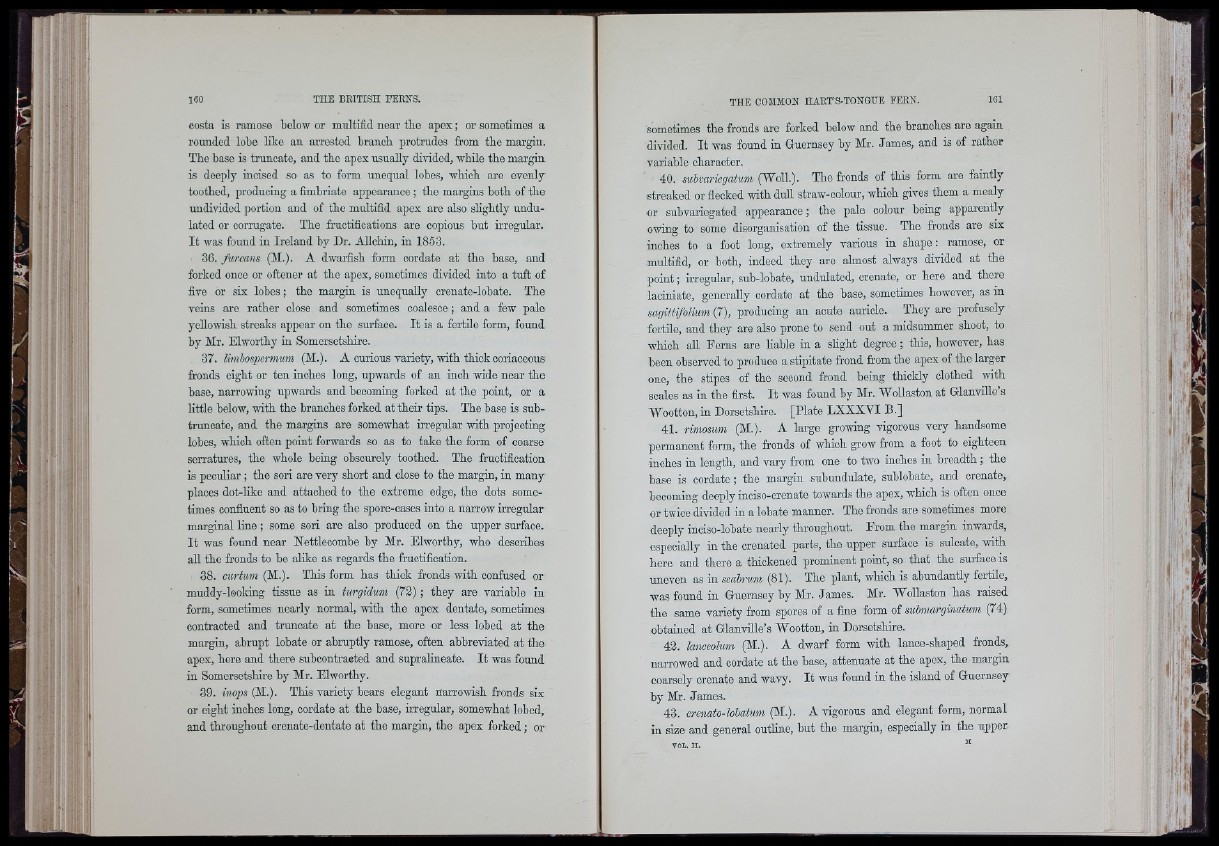
costa is ramose below or multifid near the apex; or sometimes a
rounded lobe Hke an arrested branch protrudes from the margin.
The base is truncate, and the apex usually divided, while the margin
is deeply incised so as to form unequal lobes, wliioh are evenly
toothed, producing a fimbriate appearance; the margins both of the
undivided portion and of the multifid apex are also slightly undulated
or corrugate. Tho fructifications are copious but irregular.
It was found in Ireland by Dr. Allchin, in 1853.
36. furcam (M.). A dwarfish form cordate at the base, and
forked once or oftener at the apex, sometimes divided into a tuft of
five or six lohes; the margin is unequally crenate-lobate. The
veins aro rather close and sometimes coalesce; and a few pale
yellowish streaks appear on the surface. It is a fertile form, found
by Mr. Elworthy in Somersetshire.
37. limbospermum (M.). A curious variety, with thick coriaceous
fronds eight or ten inches long, upwards of an inch wide near the
base, narrowing upwards and beooming forked at the point, or a
little below, with the branches forked at their tips. The base is suh-
truneate, and the margins are somewhat irregular with projecting
lobes, which often point forwards so as to take the form of coarse
serratures, the whole being obscurely toothed. The fruotifioation
is pecuHar ; the sori are very short and close to the margin, in many
places dot-like and attached to the extreme edge, the dots sometimes
confluent so as to bring the spore-cases into a narrow irregular
marginal line ; some sori are also produced on the upper surface.
It was found near Nettlecombe by Mr. Elworthy, who describes
aU the fronds to he ahke as regards the fruotifioation.
38. curtim (M.). This form has thick fronds with confused or
muddy-looking tissue as in turgidum (72) ; they are variable in
form, sometimes nearly normal, with the apex dentate, sometimes
contracted and truncate at the base, more or less lobed at the
margin, abrupt lobate or abruptly ramose, often abbreviated at the
apex, here and there suhcontraeted and supraHneate. It was found
in Somersetshire by Mr. Elworthy.
39. inops (M.). This variety hears elegant narrowish fronds six
or eight inches long, cordate at the base, irregular, somewhat lobed,
and throughout crenate-dentate at the margin, the apex forked; or
sometimes the fronds are forked below and the branches are again
divided. It was found in Guernsey by Mr. J ames, and is of rather
variable character.
40. suhvariegahm (Woll.). The fronds of this form aro faintly
streaked or flecked with dull straw-colour, which gives them a mealy
or subvariegated appearance; the pale colour being apparently
owing to some disorganisation of the tissue. The fronds are six
inches to a foot long, extremely various in shape; ramose, or
multifid, or both, indeed they are almost always divided at the
point; irregular, sub-lobate, undulated, crenate, or here and there
laoiniate, generally cordate at the base, sometimes however, as in
sagittifolium (7), producing an acute auricle. They are profusely
fertile, and they are also prone to send out a midsummer shoot, to
which aU. Ferns are liable in a sUght degree ; this, however, has
been observed to produce a stipitate frond from the apex of the larger
one, the stipes of the second frond being thickly clothed with
scales as in the first. It was found by Mr. W oUaston at Glanville s
AVootton, in Dorsetshire. [Plate LXXXVI B.]
41. rimosum (M.). A large growing vigorous very handsome
permanent form, the fronds of which grow from a foot to eighteen
inches in length, and vary from one to two inches in breadth ; the
base is cordate ; the margin subundulate, sublobate, and crenate,
beooming deeply inoiso-orenate towards the apex, which is often once
or twice divided in a lohate manner. The fronds are sometimes more
deeply inciso-lobate nearly throughout. From the margin inwards,
especially in the crenated parts, the upper surface is suloate, with
here and there a thickened prominent point, so that the surface is
uneven as in scabrum (81). The plant, which is abundantly fertile,
was found in Guernsey by Mr. James. Mr. AVollaston has raised
the same variety from spores of a fine form of submarginatum (74)
obtained at Glanville’s Wootton, in Dorsetshire.
42. lanceolum (M.). A dwarf form with lanoe-shaped fronds,
narrowed and cordate at the base, attenuate at the apex, the margin
coarsely crenate and wavy. It was found in the island of Guernsey
by Mr. James.
43. crenato-lobatum (M.). A vigorous and elegant form, normal
in size and general outHne, hut the margin, especially in the upper
I
li'
I ' l
ill
i!-%I.
I '1.1
I
!'
m